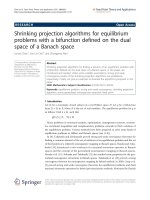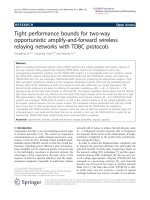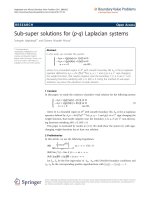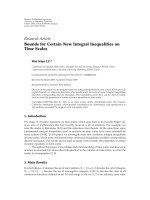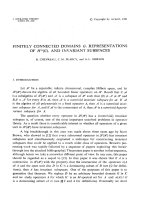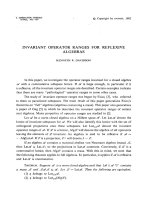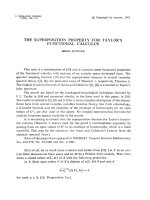Báo cáo toán học: " New Lower Bounds for Some Multicolored Ramsey Numbers" pot
Bạn đang xem bản rút gọn của tài liệu. Xem và tải ngay bản đầy đủ của tài liệu tại đây (105.89 KB, 6 trang )
New Lower Bounds for Some Multicolored Ramsey Numbers
Aaron Robertson
1
Department of Mathematics, Temple University
Philadelphia, PA 19122
email:
Submitted: October 26, 1998; Accepted November 15, 1998
Classification: 05D10, 05D05
Abstract
In this article we use two different methods to find new lower bounds for
some multicolored Ramsey numbers. In the first part we use the finite field
method used by Greenwood and Gleason [GG] to show that R(5, 5, 5) ≥ 242
and R(6, 6, 6) ≥ 692. In the second part we extend Fan Chung’s result in [C]
to show that,
R(3, 3, 3,k
1
,k
2
, ,k
r
)≥3R(3, 3,k
1
,k
2
, ,k
r
)+R(k
1
,k
2
, ,k
r
)−3
holds for any natural number r and for any k
i
≥ 3, i =1,2, r.Thisgen-
eral result, along with known results, imply the following nontrivial bounds:
R(3, 3, 3, 4) ≥ 91, R(3, 3, 3, 5) ≥ 137, R(3, 3, 3, 6) ≥ 165, R(3, 3, 3, 7) ≥ 220,
R(3, 3, 3, 9) ≥ 336, and R(3, 3, 3, 11) ≥ 422.
Introduction
This paper is presented in two part which can be read independently of each other.
Part one uses finite fields, and Part two extends an argument by Fan Chung.
Part one of this article is accompanied by the Maple package RES, available for
download at the author’s website.
Recall that N = R(k
1
,k
2
, ,k
r
) is the minimal integer with the following prop-
erty:
Ramsey Property: If we r-color the edges of the complete graph on N
vertices, then there exists j, 1 ≤ j ≤ r, such that a monochromatic j-colored
complete graph on k
j
vertices is a subgraph of the r-colored K
N
.
1
webpage: www.math.temple.edu/˜aaron
This paper is part of the author’s Ph.D. thesis under the direction of Doron Zeilberger.
This paper was supported in part by the NSF under the PI-ship of Doron Zeilberger.
the electronic journal of combinatorics 6 (1999), #R3 2
Part One: The Finite Field Method
In this first part we add two more lower bounds to Radziszowski’s Dynamic Sur-
vey [R] on the subject. We show, by using the finite field technique in [GG], that
R(5, 5, 5) ≥ 242 and R(6, 6, 6) ≥ 692. The previous best lower bound for R(5, 5, 5) was
169 given by Song [S], who more generally shows that R(5, 5, ,5
rtimes
)≥4(6.48)
r−1
+1
holds for all r.ForR(6, 6, 6) there was no established nontrivial lower bound.
Consider the number R(5, 5, 5). To find a lower bound, L, we are searching for
a three coloring of K
L
which avoids a monochromatic K
5
. We use an argument of
Greenwood and Gleason, which is reproduced here for the sake of completeness.
Let L be prime and consider the field of L elements, numbered from 0 to L − 1.
Associate each field element with a vertex of K
L
. We require that 3 divides L − 1.
Now consider the cubic residues of the multiplicative group Z
∗
L
= Z
L
\{0},which
form a coset of Z
∗
L
. Note that since 3 divides L − 1, there must be 2 other cosets.
Let i and j be two vertices of K
L
. Color the edges of K
L
as follows: If j − i is a
cubic residue color the edge connecting i and j red, if it is in the second coset, color
the edge blue, and if it is the third coset, color the edge green. (Note that the order
of differencing is immaterial since −1 is a cubic residue.)
Now suppose that a monochromatic K
5
exists in this coloring. Without loss of
generality we may call the five vertices 0, a, b, c,andd,with0<a<b<c<d.Then
the set of edges, E = {a, b, c, d, b − a, c − a, d − a, c − b, d − b, d − c}, must be a subset
of one of the cosets. Since a = 0, multiplication by a
−1
is allowed. Set B = ba
−1
,
C = ca
−1
,andD=da
−1
. Then the set a
−1
E = {1,B,C,D,B−1,C−1,D−1,C−
B, D − B, D − C} must be a subset of the cubic residues. Hence if we find an L
for which there does not exist B, C, and D such that a
−1
E is a subset of the cubic
residues, then we can conclude that R(5, 5, 5) >L. Of course, this argument holds
for R(t,t, ,t
ktimes
) for any k, and any t.
Using RES
We only acheived results when we restricted our search to fields of prime order
(although any finite field can be explored using RES (or at least easily modified to do
so)). Since we are considering the number R(5, 5, 5), reject any prime, q,forwhich3
does not divide q − 1. This can be accomplished automaticly by using the procedure
pryme. By using the procedure res we produce all of the cubic residues of Z
∗
p
, for a
given prime, p. We then use the procedure siv to discard any residue, R, for which
R − 1 is not a residue. We now have a much more manageable list to search. We
then call the procedure diffcheck to choose all possible 3-sets (for B, C,andD)and
check whether or not the differences between any two elements are all cubic residues.
If such a 3-set exists, diffcheck will output the first 3-set it finds. However, in the
event that no such 3-set exists, diffcheck will output 1.
the electronic journal of combinatorics 6 (1999), #R3 3
RES can also be used to search finite fields whose order is not prime. For example,
to verify that the field on 2
4
elements, avoids a monochromatic triangle by using cubic
residues (this fact was proven in [GG]), type GalField3(2,4,3).
By using RES we were able to find the following lower bounds: R(5, 5, 5) ≥ 242 and
R(6, 6, 6) ≥ 692. These are obtained by the following colorings: (Since −1 is a cubic
residue it suffices to list only entries up to 120 for R(5, 5, 5) and 345 for R(6, 6, 6).)
R(5, 5, 5) > 241:
Color 1: 1, 5, 6, 8, 17, 21, 23, 25, 26, 27, 28, 30, 33, 36, 40, 41, 43, 44, 47, 48,
57, 61, 64, 73, 76, 79, 85, 87, 91, 93, 98, 101, 102, 103, 105, 106, 111, 115, 116, 117
Color 2: 2, 7, 9, 10, 11, 12, 16, 19, 29, 31, 34, 35, 37, 39, 42, 45, 46, 50, 52, 54,
55, 56, 59, 60, 66, 67, 71, 72, 80, 82, 83, 86, 88, 89, 94, 95, 96, 113, 114, 119
Color 3: 3, 4, 13, 14, 15, 18, 20, 22, 24, 32, 38, 49, 51, 53, 58, 62, 63, 65, 68, 69,
70, 74, 75, 77, 78, 81, 84, 90, 92, 97, 99, 100, 104, 107, 108, 109, 110, 112, 118, 120
R(6, 6, 6) > 691:
Color 1: 1, 2, 4, 5, 8, 10, 16, 19, 20, 21, 25, 27, 31, 32, 33, 38, 39, 40, 42, 50, 51,
54, 62, 64, 66, 67, 69, 71, 73, 76, 78, 80, 83, 84, 87, 89, 95, 100, 102, 105, 107, 108,
109, 123, 124, 125, 128, 132, 134, 135, 138, 139, 142, 146, 149, 151, 152, 155, 156,
160, 163, 165, 166, 168, 173, 174, 178, 179, 181, 190, 191, 195, 199, 200, 204, 210,
214, 216, 218, 246, 248, 250, 255, 256, 259, 263, 264, 268, 270, 271, 276, 278, 283,
284, 291, 292, 293, 298, 301, 302, 304, 309, 310, 311, 312, 320, 326, 329, 330, 332,
333, 335, 336, 343, 345
Color 2: 7, 9, 11, 13, 14, 17, 18, 22, 23, 26, 28, 29, 34, 35, 36, 41, 44, 45, 46, 52,
55, 56, 58, 65, 68, 70, 72, 82, 85, 88, 90, 92, 97, 103, 104, 110, 111, 112, 115, 116, 127,
129, 130, 131, 133, 136, 140, 141, 144, 145, 147, 159, 164, 167, 170, 171, 175, 176,
177, 180, 183, 184, 189, 194, 197, 205, 206, 208, 209, 217, 220, 222, 224, 225, 227,
229, 230, 231, 232, 233, 237, 241, 243, 247, 251, 254, 257, 258, 260, 262, 266, 272,
273, 275, 279, 280, 281, 282, 288, 290, 294, 297, 303, 313, 318, 323, 325, 328, 331,
334, 337, 339, 340, 341, 342
Color 3: 3, 6, 12, 15, 24, 30, 37, 43, 47, 48, 49, 53, 57, 59, 60, 61, 63, 74, 75, 77,
79, 81, 86, 91, 93, 94, 96, 98, 99, 101, 106, 113, 114, 117, 118, 119, 120, 121, 122, 126,
137, 143, 148, 150, 153, 154, 157, 158, 161, 162, 169, 172, 182, 185, 186, 187, 188,
192, 193, 196, 198, 201, 202, 203, 207, 211, 212, 213, 215, 219, 221, 223, 226, 228,
234, 235, 236, 238, 239, 240, 242, 244, 245, 249, 252, 253, 261, 265, 267, 269, 274,
277, 285, 286, 287, 289, 295, 296, 299, 300, 305, 306, 307, 308, 314, 315, 316, 317,
319, 321, 322, 324, 327, 338, 344
the electronic journal of combinatorics 6 (1999), #R3 4
Part Two: On the Ramsey Numbers R(3, 3, 3,k
1
,k
2
, ,k
r
)
Let N = R(k
1
,k
2
, ,k
r
). The Ramsey Property implies that there must exist
agraphonN−1 vertices which avoids the Ramsey Property. Using such a graph,
along with the construction in [C], we will prove that, for any natural number r and
for any k
i
≥ 3, i =1,2, r,
R(3, 3, 3,k
1
,k
2
, ,k
r
)≥3R(3, 3,k
1
,k
2
, ,k
r
)+R(k
1
,k
2
, ,k
r
)−3.
The Construction
Fix r ≥ 1, and k
i
≥ 3fori=1,2, r.LetM=R(3, 3,k
1
,k
2
, k
r
). Then
there exists a graph, G,onM−1 vertices which avoids the Ramsey Property. Call
the incidence matrix of this graph T
r+2
= T
r+2
(x
0
,x
1
,x
2
, ,x
r+2
), where x
0
are the
diagonal entries only, and the x
i
,fori=1,2, r + 2, are the r +2 colors. By
definition of G, there are no x
1
-colored nor x
2
-colored triangles, and no x
i+2
-colored
K
k
i
,fori=1,2, r.
Now consider the following slightly modified construction from [C]:
A
DB
T
r+3
(0, 1, 2, ,r+3)= EFC
1, ,12, ,23, ,3
.
.
.
.
.
.
.
.
. G
1, ,12, ,23, ,3
the incidence matrix of a graph H on 3M + R(k
1
,k
2
, ,k
r
)−4 vertices, where
A = T
r+2
(0, 2, 3, 4, 5, ,r+3)
B=T
r+2
(0, 3, 1, 4, 5, ,r+3)
C =T
r+2
(0, 1, 2, 4, 5, ,r+3)
D=T
r+2
(3, 2, 1, 4, 5, ,r+3)
E =T
r+2
(2, 1, 3, 4, 5, ,r+3)
F =T
r+2
(1, 3, 2, 4, 5, ,r+3)
and G isanymatrixonR(k
1
,k
2
, ,k
r
)−1 vertices in the colors 4 through r +3
which avoids the Ramsey Property.
Using Fan Chung’s result [C] we see that the graph H avoids 1-colored, 2-colored,
and 3-colored triangles. We now argue that no (j + 3)-colored K
k
j
exists in H for j =
1, 2, ,r: Assume there exists a J-colored K
k
J
in H, for some J between 4 and r +3.
Then there must exist
k
J
2
entries in the 3(M −1)×3(M −1) upper left submatrix of
T
r+3
, all of value J, which form the edges of a complete graph on k
J
vertices. However,
the electronic journal of combinatorics 6 (1999), #R3 5
by the construction of T
r+3
we see that all of these entries can be taken modulo M −1,
since the entries of value J in each block are in exactly the same places as in the upper
left block, A. We further note that if (s, t)and(u, v) are two of the entries in question,
then (s, t) ≡ (u, v)(mod M −1) (componentwise). Without loss of generality we may
assume s<u.Ifwehads≡u(mod M −1), then since (u, s) must also have the same
value as (u, v), we would have (u, s) ≡ (u, u)(mod M −1). This implies that the entry
J is on the diagonal of T
r+2
(0, 2, 3, 4, ,r + 3), a contradiction. Hence, if we have
a J-colored K
k
J
in the upper left submatrix of T
r+3
(of size 3(M − 1) × 3(M − 1)),
then there must be a J-colored K
k
J
in T
r+2
(0, 2, 3, 4, ,r + 3), contradicting the
definition of T
r+2
.
Remark: Up to the renaming of colors and vertices, the above permutation configura-
tion of colors which defines T
r+3
is the only configuration which will avoid monochro-
matic triangles.
Harvesting Some Lower Bounds for Ramsey Numbers
It is amazing that the result of this section has not been observed for the 25 years
since [C] was published. Using this observation we will give 6 new lower bounds.
Currently in Radziszowski’s Survey [R], we have that R(3, 3, 3, 4) ≥ 87, due to Exoo
[E1]. By applying the result of this section to R(3, 3, 3, 4) and using the fact that
R(3, 3, 4) ≥ 30 [K], we get the new lower bound: R(3, 3, 3, 4) ≥ 91. Using the
bound R(3, 3, 5) ≥ 45 [E2,KLR], we get the bound R(3, 3, 3, 5) ≥ 137. Finally, using
R(3, 3, 6) ≥ 54, R(3, 3, 7) ≥ 72, R(3, 3, 9) ≥ 110, and R(3, 3, 11) ≥ 138 all from
[SLZL], we get the lower bounds R(3, 3, 3, 6) ≥ 165, R(3, 3, 3, 7) ≥ 220, R(3, 3, 3, 9) ≥
336, and R(3, 3, 3, 11) ≥ 422.
Acknowledgments
I would like to thank my advisor, Doron Zeilberger, for his useful comments and
insight regarding this paper. More importantly, however, I would like to thank him for
sparking my interest in combinatorics and for sharing his mathematical philosophies.
The mathematical community could benefit greatly from more mathematicians like
him.
I would also like to thank Brendan McKay for his assistance and the referee for
calling my attention to [SLZL].
References
[C] F. Chung, On the Ramsey Numbers N(3, 3, ,3; 2), Discrete Mathematics, 5,
1973, 317-321.
[E1] G. Exoo, Some New Ramsey Colorings, Electronic Journal of Combinatorics,
R29, 5, 1998, 5pp.
[E2] G. Exoo, Constructing Ramsey Graphs with a Computer, Congressus Numeran-
tium, 59, 1987, 31-36.
the electronic journal of combinatorics 6 (1999), #R3 6
[GG] R. Greenwood and A. Gleason, Combinatorial Relations and Chromatic Graphs,
Canadian Journal of Mathematics, 7, 1955, 1-7.
[K]J.Kalbfleisch,Chromatic Graphs and Ramsey’s Theorem, (Ph.D. Thesis), Uni-
versity of Waterloo, January 1966.
[KLR] D.L. Kreher, Li Wei, and S. Radziszowski, Lower Bounds for Multi-Colored
Ramsey Numbers from Group Orbits, Journal of Combinatorial Mathematics and
Combinatorial Computing, 4, 1988, 87-95.
[R] S. Radziszowski, Small Ramsey Numbers, Electronic Journal of Combinatorics,
Dynamic Survey DS1, 1994, 28pp.
[S] Song En Min, New Lower Bound Formulas for the Ramsey Numbers N(k, ,k;2)
(in Chinese), Mathematica Applicata, 6, 1993 suppl., 113-116.
[SLZL] Su Wenlong, Luo Haipeng, Zhang Zhengyou, and Li Guiqing, New Lower
Bounds of Fifteen Classical Ramsey Numbers, to appear in Australasian Journal of
Combinatorics.


